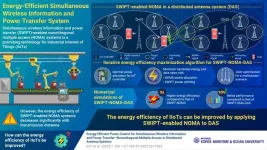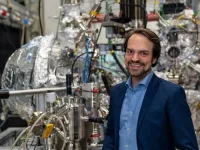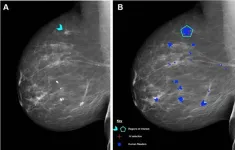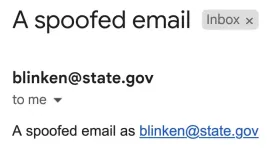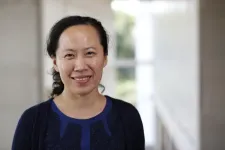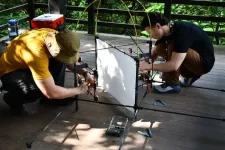(Press-News.org)
Industrial Internet of Things (IIoTs) refers to a technology that combines wireless sensors, controllers, and mobile communication technologies to make every aspect of industrial production processes intelligent and efficient. Since IIoTs can involve several small battery-driven devices and sensors, there is a growing need to develop a robust network for data transmission and power transfer to monitor the IIoT environment.
In this regard, wireless power transfer is a promising technology. It utilizes radio frequency signals to power small devices that consume minimal power. Recently, simultaneous wireless information and power transfer (SWIPT), which utilizes a single radio frequency signal to simultaneously perform energy harvesting and information decoding, has attracted significant interest for IIoTs. Additionally, with smart devices rapidly growing in number, SWIPT has been combined with nonorthogonal multiple access (NOMA) system, which is a promising candidate for IIoTs due to their ability to extend the battery life of sensors and other devices. However, the energy efficiency of this system falls significantly with transmission distance from the central controller.
To overcome this limitation, a team of researchers from South Korea, led by Associate Professor Dong-Wook Seo from the Division of Electronics and Electrical Information Engineering at Korea Maritime and Ocean University, has developed a new framework by applying SWIPT-aided NOMA to a distributed antenna system (DAS), significantly improving the energy and spectral efficiencies of IIoTs. “By applying a DAS with supporting antennas relatively close to edge users alongside a central base station, SWIPT-NOMA’s loss with growing distance can be reduced efficiently. This improves information decoding and energy harvesting performance,” explains Dr. Seo.
Their study was made available online on 27 October 2022 and published in Volume 19, Issue 7 of the journal IEEE Transactions on Industrial Informatics in 01 July 2023.
The researchers formulated a three-step iterative algorithm to maximize the energy efficiency of the SWIPT-NOMA-DAS system. They first optimized the power allocation for the central IoT controller. After that, the power allocation for NOMA signaling and power splitting (PS) assignment for SWIPT were optimized jointly, while minimizing the data rates and harvested energy requirements. Finally, the team analyzed an outage event in which the system cannot provide sufficient energy and data rates, thereby extending the joint power allocation and PS assignment optimization method to the multi-cluster scenario.
They validated their algorithm through extensive numerical simulations, finding that the proposed SWIPT-NOMA-DAS system is five times more energy efficient than SWIPT-NOMA without DAS. Also, it shows a more than 10% improvement in performance over SWIPT-OMA-DAS.
Highlighting the significance of their study, Dr. Seo says: “This technology ensures very efficient energy consumption and offers various advantages such as convenience, low power, and battery life extension. Thus, it can be applied to smartphones, laptops, wearable devices, and electric vehicles. Most importantly, the SWIPT-NOMA-DAS system can optimize resource allocation and efficiently perform wireless charging and information transmission for users in an IoT environment.”
Let us hope that this groundbreaking framework provides a significant boost to the IIoTs communications technology!
***
Reference
DOI: https://doi.org/10.1109/TII.2022.3217503
Authors: Dongjae Kim1, Minseok Choi2,, and Dong-Wook Seo3,
Affiliations:
1Artificial Intelligence Convergence Research Center for Regional Innovation, Korea Maritime and Ocean University
2Department of Electronic Engineering, Kyung Hee University
3Division of Electronics and Electrical Information Engineering, Korea Maritime and Ocean University
About National Korea Maritime & Ocean University
South Korea’s most prestigious university for maritime studies, transportation science and engineering, the National Korea Maritime & Ocean University is located on an island in Busan. The university was established in 1945 and since then has merged with other universities to currently being the only post-secondary institution that specializes in maritime sciences and engineering. It has four colleges that offer both undergraduate and graduate courses.
Website: http://www.kmou.ac.kr/english/main.do
About the author
Dong-Wook Seo is an Associate Professor of the Division of Electronics and Electrical Information Engineering at Korea Maritime and Ocean University (KMOU). Before joining KMOU, he was a senior researcher for the Defense Agency for Technology and Quality (DTaQ) and the Electronics and Telecommunication Research Institute (ETRI). He received his PhD in Electrical Engineering from the Korea Advanced Institute of Science and Technology (KAIST) in 2011. His team is currently developing next-generation high-performance electromagnetic systems for wireless communications, energy, and sensing applications.
END
This funding, part of the EU’s Horizon Europe programme, will be invested in scientific projects spanning all disciplines of research. For example, a geochemist in the Netherlands will study Venus’ atmosphere to better understand habitability beyond Earth; a computer scientist in Germany seeks to make virtual reality more inclusive to physically disabled people; a geneticist in the UK aims to analyse parasites that cause malaria; and a researcher in Israel is set to investigate how algorithms are used at work to supervise employees.
ERC President Professor Maria Leptin said: “It is part of our mission to give early-career talent the independence to pursue ambitious ...
This is the first ERC Starting Grant to be hosted at the Max Planck Institute of Microstructure Physics. ChiralTopMat aims to provide the direct experimental observation of chiral spin-hedgehogs in structurally chiral crystals and to explore ways to control their properties for applications in magnetic memory devices. Moreover, another focus will be to test the stability of topological Berry curvature monopoles against strong electronic interactions that Schröter’s group recently discovered in a chiral topological semimetal, a material that combines structural ...
OAK BROOK, Ill. – Using a standardized assessment, researchers in the UK compared the performance of a commercially available artificial intelligence (AI) algorithm with human readers of screening mammograms. Results of their findings were published in Radiology, a journal of the Radiological Society of North America (RSNA).
Mammographic screening does not detect every breast cancer. False-positive interpretations can result in women without cancer undergoing unnecessary imaging and biopsy. To improve the sensitivity and specificity of ...
A Perspective sheds light on why megaprojects take so long and cost so much—and what can be done to prevent the problem. Why did Boston’s “Big Dig” building project go 19 billion dollars over budget and take 9 years longer than anticipated? Globally, between $6 trillion and $9 trillion is spent on megaprojects every year, including everything from space telescopes to wind farms. In the United States, the recently passed $1 trillion infrastructure bill means a new era of megaprojects is at hand. In a Perspective, Guru Madhavan and colleagues review the causes behind ballooning costs and extended timelines for such megaprojects. Problems include premature ...
Researchers have developed an energy-efficient computing-based chip with smell-sensing units that can detect food spoilage and provides real-time conditions continuously throughout the spoilage process. The system is described in a study published in Advanced Science.
Other electronic noses, or artificial olfactory systems (AOSs), have been developed in the past, but they have numerous limitations, including high energy consumption, time delays, and data loss.
The AOS developed in this study requires little energy and integrates sensing and computing units on the same chip. It detects food spoilage by employing thin zinc oxide ...
Sending an email with a forged address is easier than previously thought, due to flaws in the process that allows email forwarding, according to a research team led by computer scientists at the University of California San Diego.
The issues researchers uncovered have a broad impact, affecting the integrity of email sent from tens of thousands of domains, including those representing organizations in the U.S. government–such as the majority of U.S. cabinet email domains, including state.gov, ...
Sept. 5, 2023 – In a new report posted online in the American Journal of Respiratory and Critical Care Medicine, a global consensus conference of 32 critical care experts with broad international representation and from diverse backgrounds has proposed a new definition of acute respiratory distress syndrome (ARDS). In addition to the experts, critical care societies from around the world provided input, once they received feedback from their members. The report, which builds on the 2012 Berlin Definition of ARDS, will be published Jan. 1, 2024 in the American Thoracic Society’s AJRCCM.
ARDS is a life-threatening illness in which the lungs ...
AMES, IA – During Frito-Lay's first "Crash the Super Bowl" contest in 2006, thousands of participants submitted 30-second videos promoting Doritos. Entries were winnowed down to five finalists, and a public vote selected the winning commercial, which aired during the most watched American television broadcast of the year.
The ad boosted Doritos sales and pulled in awards, sparking other big brands, like Nestlé, BMW and Fisher-Price, to launch their own crowdsourcing contests.
"Crowdsourcing has become more prevalent over the last decade. It can generate innovative ideas and solutions and engage ...
A new opinion piece published in Health Affairs Forefront raises questions around current approaches to assess drug safety and effectiveness in people with obesity. The article sheds light on how increased body fat can modify the effects of drugs used to treat common conditions, in some cases rendering the drugs ineffective or unsafe for people with obesity.
The article, titled “Assessments Of Drug Safety And Effectiveness Continue To Fail People With Obesity,” argues that drug manufacturers should be required to show correct dosing instructions on their labels ...
Over the course of four weeks this summer, a motley crew of biologists, engineers, entrepreneurs and programmers gathered at predetermined sites within Windsor Nature Park, a 185-acre tropical rainforest located in the heart of Singapore. They’d traveled from all over the world to participate in a one-of-a-kind competition hosted by the XPRIZE Foundation, in which 13 teams would have three days to identify as many organisms within the forest as possible.
Up to 10 winning teams would equally split $2 million and advance to the 2024 finals, where they’d vie for the first-place prize of $5 million. But there was a catch: All observations and data collection ...
